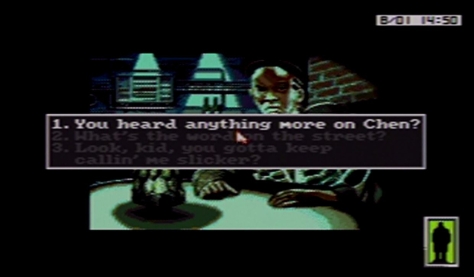
Follow video games or movies closely enough and eventually you’ll see something likened to Blade Runner. I always knew of Blade Runner, but lacked the context that comes from having seen it. Finally, that moment came for me earlier this year and I’ve been able to continue the worn-out trend of likening other entertainment to it ever since. That trend continues with this write-up of Rise of the Dragon. Originally released on home computers in 1990, it was later released on the Sega CD in 1993 (1992 for those in Japan). It’s a graphic adventure so its focus is more on solving the mystery rather than gunning down criminals, although it has that too. I encountered a few lows and many dead ends playing it, but I enjoyed it nonetheless.

Just like Blade Runner, Rise of the Dragon is set in a cyberpunk version of Los Angeles, in this instance, in 2053. The protagonist – William “Blade” Hunter – is a former cop now operating as a private detective. The game follows his work on researching the death of the mayor’s daughter. While it’s known she succumbed to her drug addiction, the mayor wants Blade to bring the culprits to justice, not necessarily for the benefit of the public so much as his personal catharsis. However, what Blade becomes embroiled in winds up being much larger than lowlife druggies. Indeed, his investigations put him in the spotlight of an ancient Chinese prophecy forecasting the end of the world.
Very early on, even immediately, the supernatural elements are present. But, the majority of the game is quite grounded, for a game set in a dingy version of LA circa 2053, that is. Exploring a handful of locations throughout LA, Blade interacts with his environment and those in it. As a graphic adventure, this entailed me moving a cursor around the environment attempting to pick up or use objects, move about, and have conversations with others. Most conversations were lengthy and branching and highlighted the game’s full voiceover – unlike the PC releases. The cursor changed to indicate when an object could be interacted with, which was very helpful.

Late in the game, “arcade” sections were also present. These shifted the gameplay from the cerebral investigative fare that composed the majority of the game to shoddy action-platforming levels that played like a bad NES movie tie-in. The diversity was appreciated, especially in a genre that I view as very narrow in terms of the way players interact with it (which admittedly, a genre I’m not the most familiar with) but these sections were downright awful. Everything about them: the character movement, platforming, and gunplay, was imprecise and just not fun. A noble attempt by the developers, but this style of game was obviously not their specialty. Thankfully, they were a minor portion and not too difficult to conquer.
Worse than the “arcade” sections was the fact that I had to restart this game twice. The first time was the game’s fault entirely. When I moved an ID card from Blade’s inventory to the environment he was in, it changed into a bomb, exploded, and disappeared. I didn’t realize this at the time and it was only when I was at one of the myriad of dead ends I encountered that I turned to GameFAQs to realize I was lacking this crucial item. Not happy, but I restarted anyways. Then, I screwed myself over losing access to not one, but both of the guns Blade acquires throughout the four days the game covers. Again, I restarted. These instances were a blessing though, as I was able to blow through all I had previously accomplished and became very familiar with the first ¾ of the game. These were disheartening events in the moment, but not so much that they lingered with me and colored my overall experience negatively.

As far as Sega CD games go, Rise of the Dragon ranks high on the list of quality experiences. It’s an enjoyable graphic adventure full of mystery and intrigue. The full voiceover honestly astounded me too, not just because it was present, but in part because it wasn’t totally garbage. Despite encountering many dead ends and having to turn to GameFAQs often, the majority of the game was fun to experience. Of course, the “arcade” sections weren’t and neither was having to restart twice, but these negative aspects didn’t turn me away. Rise of the Dragon is a worthwhile game in any Sega CD collection.
Also, I did a comprehensive playthrough of this game and published the series on YouTube. The playlist below includes the ten episodes I recorded which translates to roughly five hours with the game and chronicles everything from the game’s conclusion to the multiple times I had to start from scratch.
![Rise of the Dragon [Sega CD] – Review](https://mybrainongames.files.wordpress.com/2015/06/rise-of-the-dragon.jpg?w=672&h=372&crop=1)


















